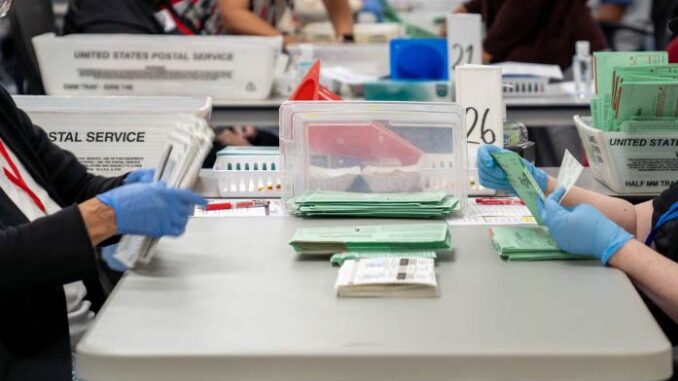
Critics are questioning an email Arizona Attorney General Kris Mayes sent to the state’s 15 county attorneys last Friday in which she insists counties do not have the authority to engage in manual tabulation of ballots, commonly referred to as hand counting.
Mayes’ warning comes on the heels of Senate Concurrent Resolution 1037, which was transmitted to Secretary of State Adrian Fontes after being passed by the Arizona Legislature in March. The resolution states that tabulating ballots by hand is allowed by those counties which do not wish to utilize automatic tabulating equipment.
Some county officials across the state consider SCR 1307 as authority to count ballots by hand instead of by machine. But the resolution is not law, Mayes pointed out.
“Any suggestion that Resolution 1037 is binding upon counties because of Legislative ‘plenary authority’ or Article I, Section 4, Clause 1 of the U.S. Constitution (the Elections Clause) is flat wrong,” Mayes advised the county attorneys.
Instead, Mayes points to four Arizona Revised Statutes written with a presumption that a county is using electronic equipment to tabulate ballots. Those statutes are ARS 16-449, 16-602, 16-621, and 16-622.
But neither those nor any other statutes contain specific language articulating the requirement for machine tabulation of ballots or to prohibit manual tabulation of ballots, according to critics of Mayes’ letter.
Critics also note Mayes concedes that ARS 16-621(C) even states an officer in charge of elections has the authority to have ballots manually counted “if it becomes impracticable to count all or a part of the ballots with tabulating equipment.”
This statute has often been interpreted by counties as meaning it is permissible to count ballots by hand if some type of problem comes up after a county announces an intent to do electronic tabulation.
Mayes’ omission of any reference to 16-602(A) in her letter to the county attorneys has also raised questions. The statute sets forth a required procedure for when “votes are cast on an electronic voting machine or tabulator.”
But if state law requires counties to always tabulate ballots by machine, there would be no need for 16-602(A), critics note.
Also missing from Mayes’ letter is any review of legislative history, including of the statutes she cited. It is one reason why the courts may end up being asked to interpret state law.
State lawmakers could, of course, step in next January to settle the issue by passing a law which specifies whether, and when, manual tabulation of ballots is allowed. The problem with the Legislature option is that counting ballots by hand does not enjoy the support of Democrats.
Tabulating ballots is a separate function from auditing ballots. A hand count audit involves counting a very small sampling of early ballots and election day ballots in a select few races to compare against the counts reported by machine tabulators in those races.
Mayes has previously taken the position that counties cannot increase the number of precincts, voting centers, or ballots used for the hand count audits beyond what is outlined in state law.
Some counties are waiting to see how the Arizona Court of Appeals rules on a case in which the Cochise County Board of Supervisors argue they have the right, as well as a duty, to audit more ballots to demonstrate confidence in the machine counts.
Supporting Cochise County’s argument is the fact Pinal County failed to count more than 500 ballots in the 2022 General Election. Those missed ballots were not discovered during a hand count audit that under the policy supported by Mayes involved only two of the county’s 97 polling places.
Problems with inaccurate machine tabulation is a key element of Abe Hamadeh’s ongoing election challenge against Mayes in the attorney general race.
In December 2023, a Mohave County judge acknowledged a small sampling of ballots counted by machine tabulators as having no vote cast (called an undervote) in that race did, in fact, have a discernable vote marked when reviewed manually.
The error rate of .0061 may seem insignificant, but in Hamadeh’s case there were more than 76,000 undervotes reported statewide. If Hamadeh is able to get a court order to recount those undervotes, then the resulting count might allow him to overcome Mayes’ 280-vote margin.
